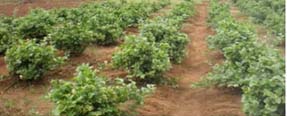cultivation practices
-
soil & climate
Well drained rich sandy loam to clay soils is most ideal. Jasmine is successfully cultivated in areas with warm summer and mild winter with plenty of water supply and sunny days. Day time temperatures of 27-32oC and night temperatures of 21-27oC are ideal. If night temperatures fall below 19oC, flower production and size are reduced.
-
land preparation
The soil is ploughed two or three times and brought to fine tilth. Pits of 45 cm3 are prepared and filled with 10-15 kg/ pit of farmyard manure and is irrigated to settle down properly.
Full dose of P and K and half dose of nitrogen are applied at the time of planting / pruning and the remaining half dose of nitrogen is applied after first flowering is over. *During the first year after planting one third of the dose of NPK is applied, for the second and third year, half of the recommended dose is applied and from the fourth year onwards full dose of NPK is applied. FYM is applied every year @10-15 kg/pit. -
input requirements
Farm yard manure : 10-15 kg/pit No. of plants per ha Jasminum grandiflorum (2 x 1.5 m) : 3000 Jasminum auriculatum/J. sambac (1.5 x 1.5 m) : 4000 Jasminum multiflorum (1.2 x 1.2 m) : 6800 Nitrogen : 120 g /plant* Phosphorus : 240 g /plant* Potash : 240 g /plant* -

Full dose of P and K and half dose of nitrogen are applied at the time of planting/pruning and the remaining half dose of nitrogen is applied after first flowering is over.
*During the first year after planting one third of the dose of NPK is applied, for the second and third year, half of the recommended dose is applied and from the fourth year onwards full dose of NPK is applied. FYM is applied every year @10-15 kg/pit.
-
pruning
Pruning is an important practice for manipulation of growth and flowering as it influences the growth, flower bud initiation, differentiation and ultimately the flower production. Normally irrigation is withheld prior to pruning and plants are pruned by removing all the past season’s shoots including dead and diseased branches. All the leaves are also stripped off. The height and time of pruning season varies in Jasminum species. While Jasminum grandiflorum is pruned at a height of 90 cm from the ground level the other species are pruned to 40- 60 cm height. Jasminum multiflorum is pruned in the months of March-April while others are pruned in November-December.
-
Induction of lean season flowering
Jasminum sambac has a distinct lean season during the peak winters (Nov to Feb). The seasonality barrier was broken by advancing pruning to September which resulted in lean season (winter) flowering. Application of the recommended dose of fertilizers (10kg FYM + 120:240:240g NPK/ plant) in four equal split doses during Feb, May, Sept and Dec on Sept pruned plants augments lean season flowering and quality of flowers during winters thereby increasing the profitability for farmers as the flower prices are high in winter. During the 1st year after planting, 1/3rd of the dose of NPK is applied, for the 2nd and 3rdyear, 1/2 of the recommended dose is applied and from the 4th year onwards full dose of NPK is applied.
-
propagation
Jasmines are usually propagated by cutting and layering. Seed propagation is used for crop improvement only.
Cuttings: This is the easiest method of propagation. Generally 15-20 cm length of cuttings either from terminal or semi hardwood portion of the stem is suitable for propagation. The cuttings are planted in coarse sand media under intermittent mist for better rooting. To improve the rooting percentage, treatment of cuttings with IBA 4000 ppm is recommended. The ideal months for propagation are June to September.
-
Layering: Simple layering during June-July to October-November gives good success in 90-120 days.

Irrigation
Normally irrigation is done by flooding once a week or irrigating at 60% available moisture which increases flower yield. Manual weeding or mulching is done to control weed growth.
-
Harvesting and yield
The stage of harvest depends on the use of flowers. For fresh flowers, fully developed unopened flower buds are picked early in the morning while for concrete extraction, fresh fully opened flowers are harvested preferably before 9 am. For long distance transport, corrugated cardboard boxes are used whereas for local market, bamboo baskets lined with cloth or paper are used on which water is sprinkled. For export, the flowers of J. sambac treated with 4% boric acid and packed in aluminium foil lined boxes + packaging in thermocole boxes under gel-ice cold condition had shelf life of 42.88 h (including the air transit time of 36 h).

 Jasmine
(Jasminum spp.) is the native of tropical and
subtropical regions. It belongs to the family Oleaceae.
It is used for ceremonial purpose, as religious
offerings, in the perfumery industry, flavouring tea and
in traditional medicines since time immemorial.
Jasmine
(Jasminum spp.) is the native of tropical and
subtropical regions. It belongs to the family Oleaceae.
It is used for ceremonial purpose, as religious
offerings, in the perfumery industry, flavouring tea and
in traditional medicines since time immemorial.